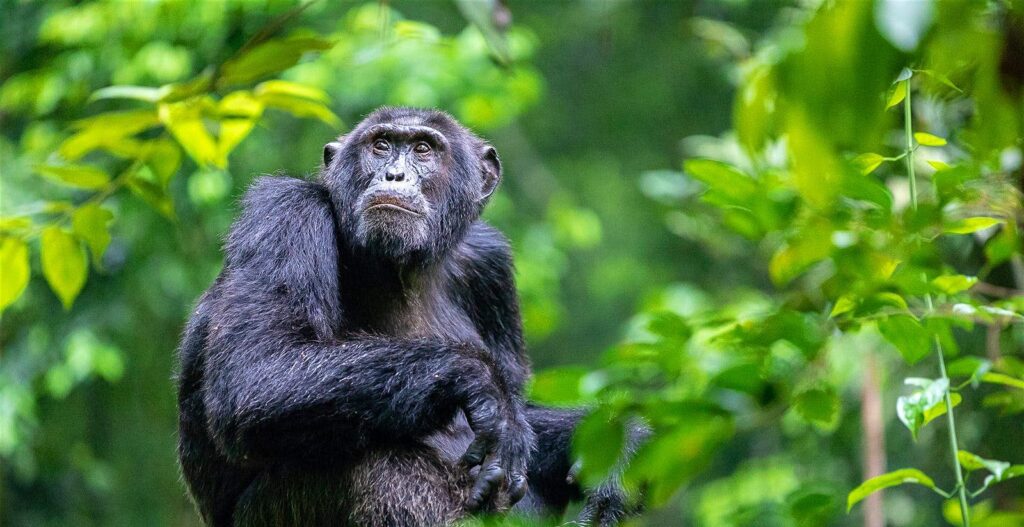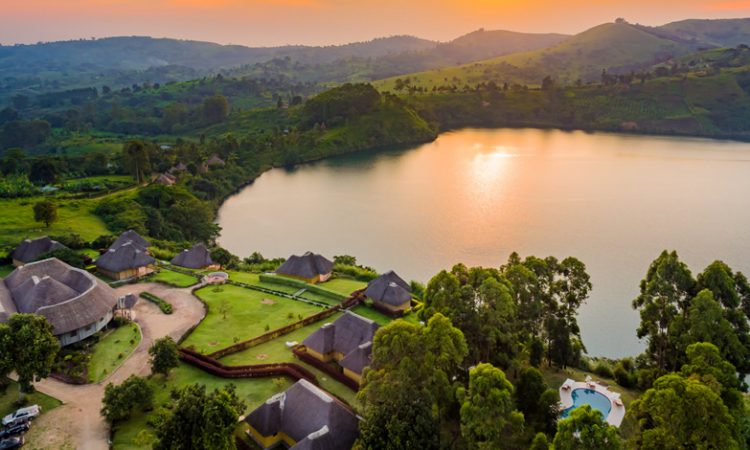Kibale National Park is a haven for rainforest adventures. With temperatures ranging from a pleasant 14°C to 27°C year-round, it’s a place to truly escape the heat.
Nicknamed the “primate capital of East Africa,” Kibale boasts 13 primate species, including a whopping 1,450 chimpanzees! This makes it the undisputed champion for chimp trekking in East Africa. The park’s chimps have been accustomed to human presence for over 26 years, allowing you a rare chance to observe them in their natural habitat.
Treks to see chimpanzees in Kibale require participants to be 15 years or older. However, there’s an alternative! Ngamba Island Chimpanzee Sanctuary, located on Lake Victoria near Entebbe, offers a viewing platform where visitors can observe chimps during their midday feeding.
Kibale’s diverse landscape, ranging from woodlands and savannas to wet tropical forests and dry forests, creates a unique patchwork of ecosystems. This rich variety attracts a fascinating array of wildlife, each species perfectly adapted to its chosen habitat.
Wildlife in Kibale National Park
While chimpanzees steal the show at Kibale National Park, the forest teems with a surprising diversity of mammals. Estimates suggest over 60 species call Kibale home, including leopards, duikers, forest elephants, forest buffaloes, golden cats, warthogs, and bush pigs.
Unlike the wildlife in bustling savannas, Kibale’s creatures tend to be more secretive.
The dense vegetation provides excellent cover, and with fewer visitors compared to other parks, they have less reason to venture out in the open. This means you might be lucky enough to see elephants, buffaloes, or bush pigs on your visit, but more often you’ll spot their tracks – a reminder of their hidden presence.
The true stars of Kibale are undoubtedly the primates. With 13 different species, the park is a paradise for primate enthusiasts. Look out for fascinating creatures like bush babies, L’Hoest’s monkeys, red colobus monkeys, and many more. Chimpanzee trekking and habituation experiences are the main draws for visitors, offering a unique chance to encounter our closest relatives in their natural habitat.
Birds
It also is a top birding destination with over 375 avian residents. This impressive count is thanks to Kibale’s diverse habitats and dense vegetation, providing a safe haven and abundant food for feathered friends.
Birding adventures typically occur early mornings and late evenings to target both diurnal and nocturnal birds. The elusive, Green-breasted Pitta is a major draw for birders visiting Kibale. But that’s just the tip of the wing! Keep your eyes peeled for a dazzling array of species, including red-chested Owlet, Purple-breasted Sunbird, African Grey Parrot, Blue-breasted Kingfisher, Crowned Eagle, Little Greenbul, Black Bee-eater, White-naped Pigeon, Scaly-breasted Illadopsis, Nahan’s Francolin (endemic to the Albertine Rift!), Dusky-blue Flycatcher etc.
The park boasts over 250 dazzling butterfly species. Unlike the shy reptiles and amphibians, these winged beauties will be flitting about, adding splashes of color to your rainforest adventure.
Activities to do in Kibale National Park
Chimpanzee Trekking
Kibale National Park’s crown jewel is undoubtedly the chimpanzee trek. Since 1993, visitors have had the chance to encounter our closest relatives in their natural rainforest habitat.
Treks are offered twice daily: early morning at 8am and afternoon at 2pm. While both offer exciting opportunities, the morning trek is often recommended for higher chimp activity. Before embarking on your trek, a park ranger will provide a briefing. You’ll learn about chimp behavior, park etiquette, and other fascinating wildlife in Kibale. Skilled trackers head out before your group, locating where the chimps nested the night before.
This dynamic approach ensures you spend valuable time observing these intriguing creatures.
Prepare for a walk! Sturdy, waterproof boots are essential. Long-sleeved clothing and pants offer protection from vegetation and insects. Pack a rain poncho – tropical downpours can happen anytime. Binoculars and a camera will help you capture unforgettable memories. Don’t forget insect repellent to keep pesky bugs at bay.

Chimpanzee Habituation
Have you ever dreamed of spending a day with chimpanzees in their natural habitat? Kibale National Park’s Chimpanzee Habituation Experience offers a unique opportunity to do just that.
This program goes beyond a typical chimp trek. It allows you to join researchers and rangers every morning as they habituate a specific chimpanzee family. Habituation is a multi-year process where chimps gradually become accustomed to human presence.
You’ll witness chimps emerging from their overnight nests, embarking on their daily routines. Observe them feeding, hunting, playing, caring for young, and navigating their social hierarchy. With repeated visits, these chimps become comfortable with human observers, eventually allowing for regular tracking experiences.
The program provides a fascinating glimpse into chimpanzee society. It’s a chance to learn about their behavior, communication, and family dynamics directly from the experts who study them.
Bird Watching in Kibale National Park
Kibale Forest isn’t just a haven for primates, it’s a paradise for birdwatchers with over 375 avian residents. Embark on a rewarding birding adventure with morning walks starting at 7:00 am. Be sure to book in advance to ensure the rangers are prepared for your arrival.
Kibale boasts a stunning variety of birds, including several species endemic to the Albertine Rift. The elusive Green-breasted Pitta is a top target for many birders, but keep your ears peeled for a chorus of other captivating calls. They include; Grey-throated Flycatcher, Grey-winged Robin, Crested Flycatcher, Blue-shouldered Robin Chat, Yellow-spotted Barbet, Black-billed Turaco etc.
Nature walks and hikes
This adventure delves deeper into the forest’s heart, offering ample opportunity to spot a wider variety of birds and animals. You might encounter elusive bush pigs, duikers, or even elephants (with a bit of luck!). Important Note: This trek is only available during the dry season (December – February and June – September) due to challenging trail conditions in the wet months.
Night walks
For a completely different perspective, embark on a captivating night walk. Starting at 7:00 pm, these 2.5-hour adventures reveal the nocturnal side of the forest. Accompanied by experienced rangers with powerful torches, you might glimpse fascinating creatures like bush babies, hyraxes, pottos, and even the occasional serval cat or civet.

Culture and community experiences
Bigodi Wetland Sanctuary
This is a community run Sanctuary located 6km south of Kibale National Park. It is home to about 200 bird species including some fascinating species like the great Blue Turaco. Primate species like the grey checked mangabey, red tailed, black and white colobus monkey, beautiful butterflies. The walk through these beautiful grasslands, takes about 3 hours. Embark on a community-led walk through this vibrant wetland, a haven for over 138 bird species. Witness firsthand how the local community actively protects this vital ecosystem.
Explore Local Crafts: Support women-led projects by purchasing beautiful handmade crafts, a unique reminder of your Ugandan adventure.
A Taste of Tradition: Immerse yourself in local culture with a traditional meal prepared by the lovely Tinka family. Savor delicious home-cooked fare surrounded by warm hospitality.
Community Connection: Visit a local school and connect with the future generation of Kibale. This heartwarming experience fosters cultural exchange and understanding.
These community experiences provide a deeper understanding of the people who call Kibale home and their dedication to preserving the park’s natural and cultural treasures.
How to get to Kibale National Park
Here are several routes to consider, depending on your travel style and itinerary:
Fly in Style: Take a scheduled or chartered flight from Entebbe International Airport to Kasese airstrip. This convenient option lands you just an hour away from the park.
Classic Road Trip: Embark on a scenic drive from Kampala. The recommended direct route takes you via Fort Portal to Kibale Forest.
Flexible Stopover: Traveling through Ibanda? Consider the Kampala – Mbarara – Kibale Forest route via Ibanda. This option allows for a potential stopover and activity in Ibanda.
Multi-Park Adventure: Connecting Kibale with Queen Elizabeth National Park? Choose either route:
Queen Elizabeth National Park – Kasese – Fort Portal – Kibale Forest (ideal for a direct connection)
Queen Elizabeth National Park – Kasese – Kasekende Craters – Kibale Forest (add a unique stop at the Kasekende Craters)
Accommodation available in Kibale National Park include Turaco Treetops, Chimpanzee Guest house, Kibale forest camp, Isunga Lodge, Ndali Lodge, Primate Lodge, Kyaninga Lodge.

